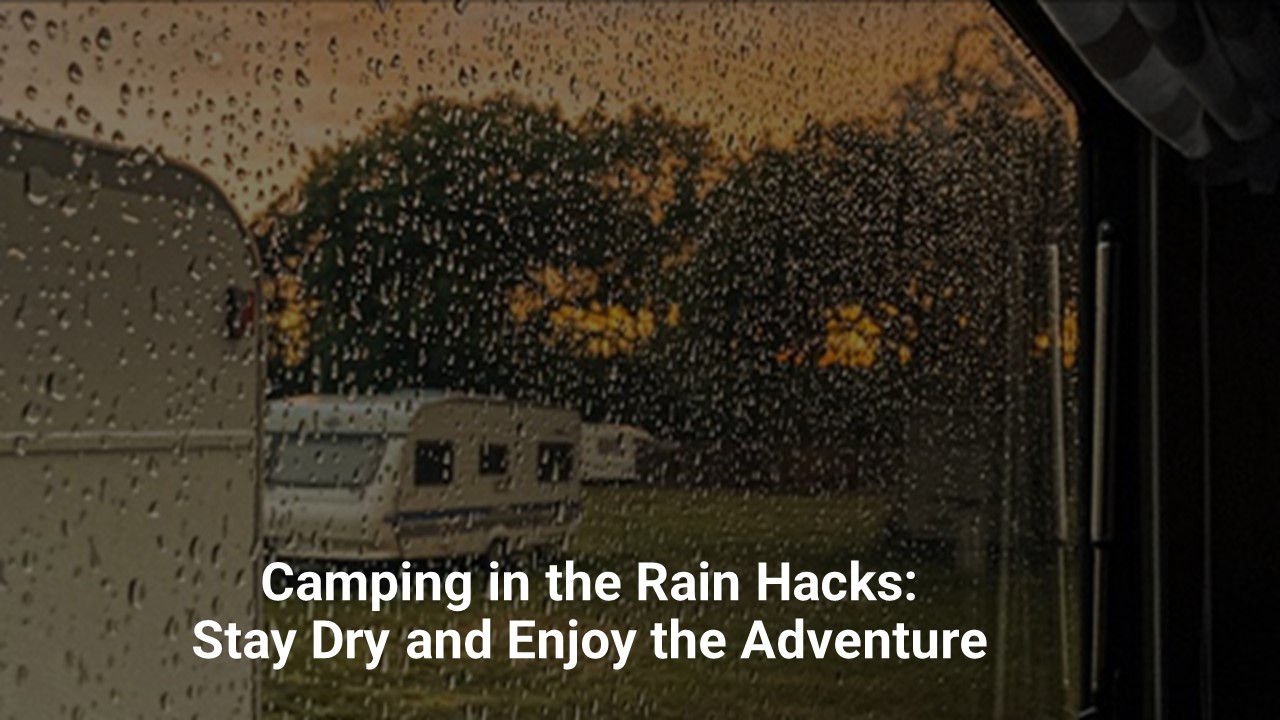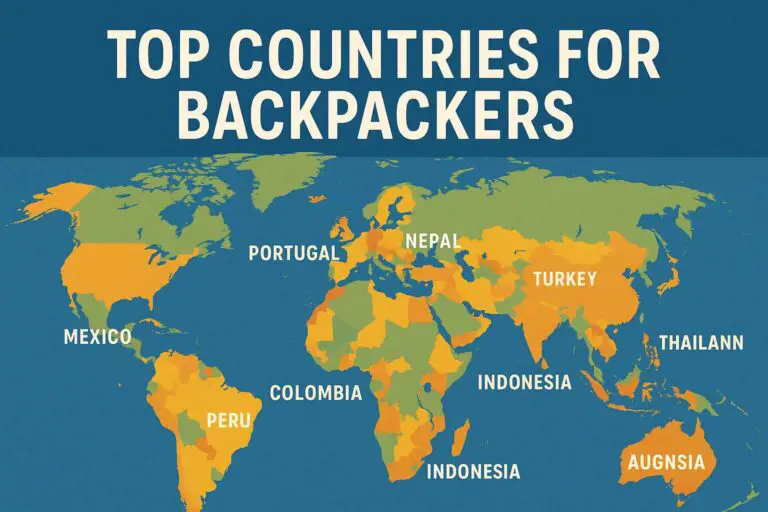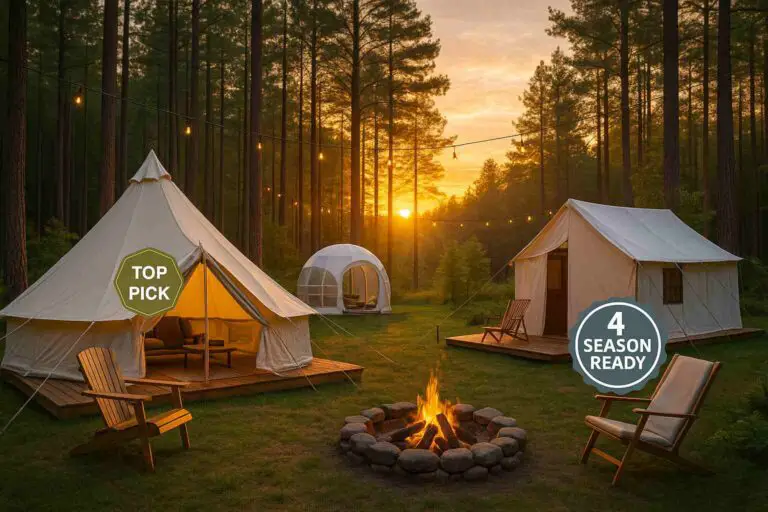If there’s one thing I’ve learned from my camping experiences, it’s that Mother Nature doesn’t always play by the rules. Rainy camping trips might not be what you expect, but with the right hacks and a positive attitude, you can turn them into some of the most memorable and rewarding adventures you’ll ever have.
While rainy camping may seem daunting, I’ll share some expert tips and ingenious hacks to keep you dry and cozy throughout your escapade. From choosing the perfect waterproof tent to mastering the art of tarp setup, waterproofing your gear, and selecting the ideal campsite, I’ll equip you with all the knowledge you need to conquer any downpour with a smile.
Let’s get started!
Choose the Right Tent
When it comes to camping in the rain, choosing the right tent is crucial to ensure a dry and comfortable experience. Here are some essential tips to guide you in selecting the perfect tent for your rainy adventures:
- Waterproof Materials: Look for tents made from high-quality waterproof materials, such as ripstop nylon with a durable water-repellent (DWR) coating. These materials prevent water from seeping through the tent walls and roof.
- Taped Seams: Check that the tent has taped seams. Seam tape is applied to the stitching on the tent’s rainfly and floor to create a barrier against water infiltration through needle holes.
- Bathtub Floor Design: A tent with a “bathtub floor” design means the floor rises a few inches up the tent walls before curving downward. This design helps prevent water from entering the tent during heavy rainfall.
- Vestibules or Rainfly Coverage: Opt for a tent that has vestibules or a generously sized rainfly. Vestibules provide covered storage space for gear and muddy shoes, while a rainfly that extends over the tent’s entrance offers extra protection against rain and allows for a dry entry and exit.
- Double-Walled Tents: Consider a double-walled tent, which consists of an inner tent and a rainfly. This design minimizes condensation buildup inside the tent and provides an added layer of protection against rain.
- Size and Height: Choose a tent that comfortably accommodates the number of campers and gear you’ll have. A taller tent allows for more headroom and reduces the risk of brushing against wet tent walls.
- Ventilation: Adequate ventilation is essential to minimize condensation inside the tent. Look for tents with mesh panels or windows that can be zipped shut during rain showers.
- Ease of Setup: When the rain starts pouring, you’ll be grateful for a tent that can be pitched quickly and easily. Practice setting up your tent beforehand to ensure you can do it efficiently in challenging weather conditions.
- Reviews and Recommendations: Read customer reviews and seek recommendations from experienced campers. Their feedback can provide valuable insights into a tent’s performance in rainy conditions.
- Test it out: If possible, set up your tent in your backyard or a nearby park during a light rain shower to see how it holds up. This will give you confidence in your tent’s ability to keep you dry during your actual camping trip.
Investing in a reliable waterproof tent is one of the best ways to enjoy your rainy camping adventure to the fullest.
Pre-Trip Waterproofing
Before embarking on your rainy camping trip, it’s essential to take some pre-trip waterproofing measures to ensure your tent stays dry and cozy during unexpected downpours. Here are 8 tried and tested tips to waterproof your tent and gear:
- Seam Sealing: Seam sealing is a critical step in keeping water from seeping through the tiny needle holes along the tent seams. Most tents come with factory-taped seams, but it’s a good idea to inspect them and reseal if necessary. Purchase a seam sealer kit from your local outdoor store, follow the instructions, and apply the sealant to all the seams.
- Rainfly Treatment: The rainfly is your tent’s first line of defense against rain. Enhance its water repellency by applying a waterproof spray or DWR treatment. Before spraying, ensure the rainfly is clean and dry. Follow the product guidelines, and remember to focus on seams and areas that are likely to be exposed to rain.
- Tent Floor Protection: Prevent ground moisture from seeping into your tent by using a groundsheet or footprint. A groundsheet acts as a protective layer between the tent floor and the wet ground. You can use a purpose-built footprint provided by the tent manufacturer or create one using a tarp cut to fit the tent dimensions.
- Floor Seam Sealing: While seam sealing the tent seams, don’t forget about the floor seams. These can also be potential entry points for water. Use the same seam sealer to protect the tent floor from moisture infiltration.
- Pack Waterproof Gear Bags: Keep your gear dry and organized by packing them in waterproof stuff sacks or dry bags. This is especially important for clothes, electronics, and anything you wouldn’t want to get soaked during the trip.
- Waterproof Your Backpack: Line the interior of your backpack with a trash compactor bag or a purpose-built waterproof liner. This added layer of protection shields your gear from water, even if your backpack gets wet during the trip.
- Rain Gear Check: Ensure your rain gear, such as rain jackets, waterproof pants, and rain boots, are in good condition and ready to take on the rain. Double-check for any tears, wear, or damage that might compromise their waterproof abilities.
- Practice Setting Up in the Rain: If possible, practice setting up your tent in your backyard during a light rain shower or simulate rain conditions using a garden hose. This exercise will familiarize you with the tent’s setup process and help you identify any potential leaks or issues.
Remember, a little preparation goes a long way in ensuring a dry and enjoyable camping experience, rain or shine!
Master the Art of Tarp Setup
Mastering the art of tarp setup is a game-changer when it comes to camping in the rain. Tarps provide essential protection and help create a dry and comfortable sheltered space outside your tent. Here’s how you can become a tarp setup pro:
- Choose the Right Tarp: Select a tarp that is large enough to cover the area you need, but not so big that it becomes difficult to manage. A 10×10 feet tarp is a versatile size for most camping setups.
- Gather the Necessary Gear: You’ll need guy lines, stakes, and adjustable poles or trees to set up your tarp. Carry extra stakes and guy lines in case you need them.
- Create a Rain-Free Zone: Set up the tarp over the entrance of your tent to create a covered area, commonly known as a vestibule. This space acts as a buffer zone where you can remove wet gear, muddy shoes, and rain-soaked clothes before entering your dry tent.
- Pitch the Tarp at an Angle: To ensure water runoff, pitch the tarp at a slight angle with one corner lower than the others. This will allow rainwater to flow away from your tent and the covered area.
- Tension the Tarp Properly: Tightly secure the tarp using guy lines and stakes. Proper tensioning prevents water from pooling on the tarp, which could lead to leaks or sagging.
- Elevate the Tarp: If possible, set up the tarp slightly higher in the middle than at the edges. This helps water run off more effectively, minimizing the risk of water collecting on the tarp.
- Use a Tarp as a Groundsheet: Lay a tarp underneath your tent to provide an additional layer of protection against ground moisture. This prevents water from seeping through the tent floor, ensuring a dry and comfortable interior.
- Experiment with Different Configurations: Get creative with your tarp setup. Depending on the weather conditions and your campsite, you can try different configurations, such as A-frame, lean-to, or diamond shapes, to find the most effective setup for rain protection.
- Carry Adjustable Poles: If trees aren’t available, bring adjustable tent poles or hiking poles that allow you to create a makeshift support structure for your tarp. These versatile poles enable you to set up the tarp in various terrains.
- Practice Makes Perfect: Before your camping trip, practice setting up the tarp in your backyard or nearby park. Familiarize yourself with the process, so you can efficiently set it up when it matters the most.
By mastering the art of tarp setup, you’ll have a dry, covered space to relax, cook, and enjoy the outdoors even during a rainy camping trip. Plus, you’ll impress your fellow campers with your tarp-tastic skills! So, don’t hesitate to unleash your inner tarp maestro and turn rainy days into enjoyable adventures!
Elevate Your Sleeping Gear
Elevating your sleeping gear is a fantastic way to ensure a dry and comfortable night’s rest during rainy camping trips. By keeping your sleeping gear off the ground, you protect it from potential ground moisture and puddles. Here are 8 tips to elevate your sleeping setup:
- Camping Cot or Inflatable Mattress: Investing in a camping cot or an inflatable mattress is an excellent choice for staying dry and cozy. These elevated platforms keep you off the ground, providing an insulated barrier between you and any dampness below.
- Choose a Raised Tent Platform: If your campsite offers raised tent platforms, take advantage of them! These platforms are designed to keep campers above the ground, making them ideal for rainy conditions.
- Camping Hammock: Camping in a hammock can be a fun and effective way to stay dry during rainy nights. Pair your hammock with a waterproof rainfly or hammock-specific tarp to create a dry sleeping cocoon.
- Use a Camping Pad: If you prefer sleeping in a traditional tent, place a camping pad or foam pad underneath your sleeping bag. While not as elevated as cots or hammocks, camping pads provide some insulation from the cold and dampness of the ground.
- Create a Raised Platform: In areas where ground moisture is a significant concern, get creative and build a raised platform using logs, branches, or rocks. This DIY approach elevates your sleeping area and helps prevent water from seeping into your sleeping bag.
- Avoid Low-Lying Areas: When choosing your campsite, steer clear of low-lying areas where water might pool during heavy rain. Opt for higher ground to reduce the risk of waking up in a soggy situation.
- Properly Pitch Your Tent: If you decide to sleep in a tent, ensure it’s pitched correctly to prevent water from flowing into the tent. Make sure the rainfly is taut and sloped away from the tent to encourage water runoff.
- Keep Gear Inside the Tent: While your sleeping gear is elevated, avoid leaving other gear outside the tent. Keep your backpack and any other belongings inside to protect them from potential rain and dew.
Whether you choose a camping cot, hammock, or a simple camping pad, staying off the ground ensures a dry and comfortable camping experience even when the rain decides to join the party!
Waterproof Your Gear
Waterproofing your gear is essential to keep your belongings dry and functional during rainy camping trips. Here are ten effective ways to ensure your gear stays dry even in the wettest conditions:
- Waterproof Stuff Sacks or Dry Bags: Invest in waterproof stuff sacks or dry bags to protect your clothes, sleeping bag, electronics, and other essentials. Pack each item into individual waterproof bags to create multiple layers of protection against water infiltration.
- Use Ziplock Bags: For smaller items like electronics, maps, and first-aid supplies, double up their protection by placing them in Ziplock bags before putting them inside larger waterproof bags. This extra layer will prevent water from seeping through any potential openings.
- Trash Compactor Bags: Line the interior of your backpack with a large, heavy-duty trash compactor bag or a waterproof liner. This acts as an additional safeguard against rain and keeps your gear dry, even if your backpack gets wet.
- Dry Cases for Electronics: If you plan to bring cameras, phones, or other electronic devices, invest in dry cases or dry pouches designed specifically for electronics. These protective cases allow you to use your devices while keeping them safe from water damage.
- Protect Your Documents: Store important documents like camping permits, ID cards, and maps in waterproof document pouches. These pouches will prevent crucial paperwork from becoming waterlogged and unreadable.
- Waterproof Footwear: Ensure your footwear is up to the challenge by treating them with a waterproofing spray or wax. This extra layer of protection will keep your feet dry and comfortable during rainy hikes.
- Rain Covers for Backpacks: Many backpacks come with built-in rain covers or have rain covers available as an accessory. If yours doesn’t, consider investing in a rain cover that fits your specific backpack model to shield it from rain showers.
- Waterproof Tent and Rainfly: If you have a double-walled tent, ensure the rainfly is waterproofed as mentioned in the pre-trip waterproofing section. For single-walled tents, ensure they are made from high-quality waterproof materials to keep you dry during the night.
- Tarp for Extra Protection: Set up a tarp over your camping area to provide an extra layer of protection against rain. This creates a dry space where you can cook, eat, or relax without worrying about getting wet.
- Regular Maintenance: Keep your gear in good condition by regularly checking for any tears, holes, or worn-out areas that may compromise its waterproofing. Repair or replace damaged gear before heading out on your rainy adventure.
With these waterproofing tips, you’ll have peace of mind knowing that your gear is shielded from the rain’s unwelcome intrusion.
Keep a Dedicated Rain Gear
When camping in the rain, having dedicated rain gear is essential to keep yourself dry and comfortable throughout the trip. Here’s how you can make the most of your rain gear and stay prepared for any unexpected showers:
- Invest in a Quality Rain Jacket: A high-quality rain jacket is a must-have for any camper venturing into wet weather. Look for a jacket with waterproof and breathable properties to keep you dry from the rain while allowing sweat and moisture to escape from the inside.
- Waterproof Pants: Pair your rain jacket with waterproof pants to ensure full-body protection. Waterproof pants act as a shield against rain and mud, keeping your legs dry and warm.
- Rain Poncho: For a versatile option, consider a rain poncho. Ponchos are easy to slip on over your clothes and backpack, providing excellent coverage against rain.
- Gaiters: Gaiters are essential for hikers and campers who might encounter wet and muddy trails. These protective coverings fit over your shoes and lower legs, preventing water, mud, and debris from entering your footwear.
- Waterproof Footwear: Keep your feet dry by wearing waterproof hiking boots or rubber rain boots. Opt for breathable and durable footwear designed specifically for wet conditions.
- Pack Extra Rain Gear: Always have an extra set of rain gear, especially if you’re camping for an extended period. Having a spare rain jacket and pants ensures you’ll have dry clothing to change into if the weather takes a turn for the worse.
- Rain Hat or Hood: Protect your head from the rain with a rain hat or a jacket with a reliable hood. A well-fitted hood will keep raindrops from trickling down your neck and face.
- Waterproof Gloves: Don’t forget about your hands! Waterproof gloves will not only keep your hands dry but also provide insulation to prevent them from getting cold in wet conditions.
- Quick-Drying Clothing: Opt for quick-drying and moisture-wicking clothing materials, even underneath your rain gear. These fabrics will help keep you comfortable by wicking away sweat and moisture.
- Keep Rain Gear Accessible: Keep your rain gear easily accessible, either in an outer compartment of your backpack or in a waterproof stuff sack. You don’t want to be rummaging through your entire pack when the rain starts pouring.
With dedicated rain gear on hand, you’ll be well-prepared to tackle the rain with a smile on your face.
Choose the Right Campsite
Choosing the right campsite is crucial for a pleasant and dry camping experience during rainy conditions. Here are 10 tips to help you select the perfect spot for your rainy camping adventure:
- Elevation and Drainage: Opt for a campsite on higher ground to avoid potential flooding during heavy rains. Steer clear of low-lying areas where water might collect, and instead, look for spots with good natural drainage to allow rainwater to flow away from your tent.
- Avoid Sloping Ground: While drainage is essential, avoid pitching your tent on steeply sloping ground. If rainwater accumulates and starts flowing downhill, it could create a soggy and uncomfortable camping experience.
- Natural Windbreaks: Look for natural windbreaks, such as dense trees or large rocks, to provide some protection from strong winds and heavy rain. A sheltered location will make your camping experience more enjoyable.
- Distance from Water Sources: While camping near a water source has its benefits, avoid setting up camp too close to rivers, streams, or lakes during rainy weather. Water levels can rise quickly, leading to potential flooding in the vicinity.
- Overhanging Branches: While natural coverage from trees can be useful, be cautious of overhanging branches above your tent. Heavy rain could cause water to drip onto your tent, leading to leaks.
- Campsite Orientation: Pay attention to the direction of prevailing winds in the area. Position your tent’s entrance and rainfly to face away from the wind, ensuring rain doesn’t blow directly into your shelter.
- Check for Existing Drainage Channels: Before setting up your tent, inspect the ground for any signs of existing drainage channels or paths that rainwater might follow. Avoid camping in these areas to prevent water from pooling around your tent.
- Know the Local Climate: Research the local weather patterns and rainfall tendencies of the camping area. Some regions experience more frequent and intense rainfalls, so knowing what to expect will help you plan accordingly.
- Prioritize Safety: Choose a campsite that prioritizes your safety. Avoid areas prone to flash floods, landslides, or other natural hazards, and make sure you’re camping within designated camping zones.
- Leave No Trace: Follow Leave No Trace principles and camp in designated camping areas to minimize your impact on the environment. This ensures you’re not camping in sensitive or ecologically fragile regions that could be negatively affected by your presence, especially during wet weather.
Keep the Interior Dry
Keeping the interior of your tent dry is crucial for a comfortable and enjoyable camping experience during rainy weather. Here are 10 tips to help you maintain a dry and cozy tent interior:
- Tarp at the Entrance: Set up a tarp or rainfly over the entrance of your tent to create a covered area, commonly known as a vestibule. This space acts as a buffer zone where you can remove wet gear, muddy shoes, and rain-soaked clothes before entering your dry tent.
- Wipe Your Feet: Place a small towel or a doormat outside the tent entrance to wipe your feet and shoes before stepping inside. This prevents excess moisture and dirt from entering the tent.
- Designate a Wet Gear Area: Inside the tent, designate a specific area for wet gear and clothing. Keep all damp items away from your sleeping area to avoid transferring moisture to your sleeping bag or sleeping pad.
- Avoid Touching Tent Walls: During rainy conditions, avoid touching the tent walls with your hands or any wet items. Touching the walls can transfer water and potentially cause leaks or wet patches inside the tent.
- Properly Ventilate the Tent: Condensation can build up inside the tent, especially during rainy weather when the air is humid. Properly ventilate your tent by partially opening vents or windows to allow for air circulation and reduce condensation.
- Use a Small Sponge or Cloth: Keep a small sponge or cloth handy inside the tent to wipe away any moisture that may accumulate on the walls or ceiling. Regularly check for dampness and dry any affected areas to prevent mold or mildew.
- Organize Gear with Dry Bags: Use dry bags or waterproof stuff sacks to organize and store your gear inside the tent. Keeping everything in waterproof containers ensures that even if water does get inside the tent, your gear remains dry and functional.
- Be Mindful of Openings: When entering or exiting the tent during rain, be quick to zip and close the door to prevent rain from entering. Teach your camping companions to do the same to maintain a dry interior.
- Check for Leaks: Before your camping trip, inspect your tent for any potential leaks. Set up the tent in your backyard during a simulated rain shower or use a hose to check for weak spots and address them beforehand.
- Keep the Rainfly Secure: Ensure the rainfly is securely attached to the tent to provide maximum protection from rain and wind. Tightly stake down the rainfly and guy out any loose areas to prevent water from pooling on the tent roof.
Conclusion
In conclusion, camping in the rain can be a truly memorable and enjoyable experience with the right hacks and preparation. Embracing the challenges of wet weather allows you to connect with nature in a unique way and opens the door to unforgettable adventures.
However, it’s important to acknowledge that camping in the rain comes with its challenges, and despite your best efforts, nature can sometimes be unpredictable. Always stay informed about weather conditions before your trip and be prepared to adjust your plans if necessary. Safety should be your top priority, and in extreme weather situations, it might be best to postpone your camping adventure.
So, be well-prepared, stay flexible, and embrace the magic of camping in the rain. With the right approach and a touch of adventure, you can create cherished memories and strengthen your connection with the great outdoors, no matter what weather Mother Nature brings your way. Happy camping!








